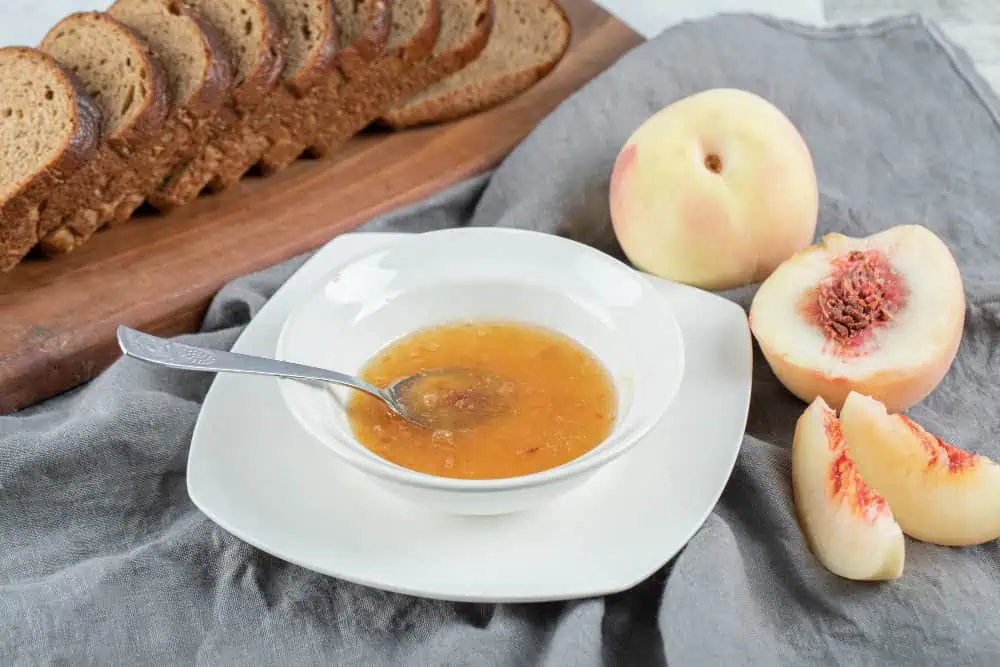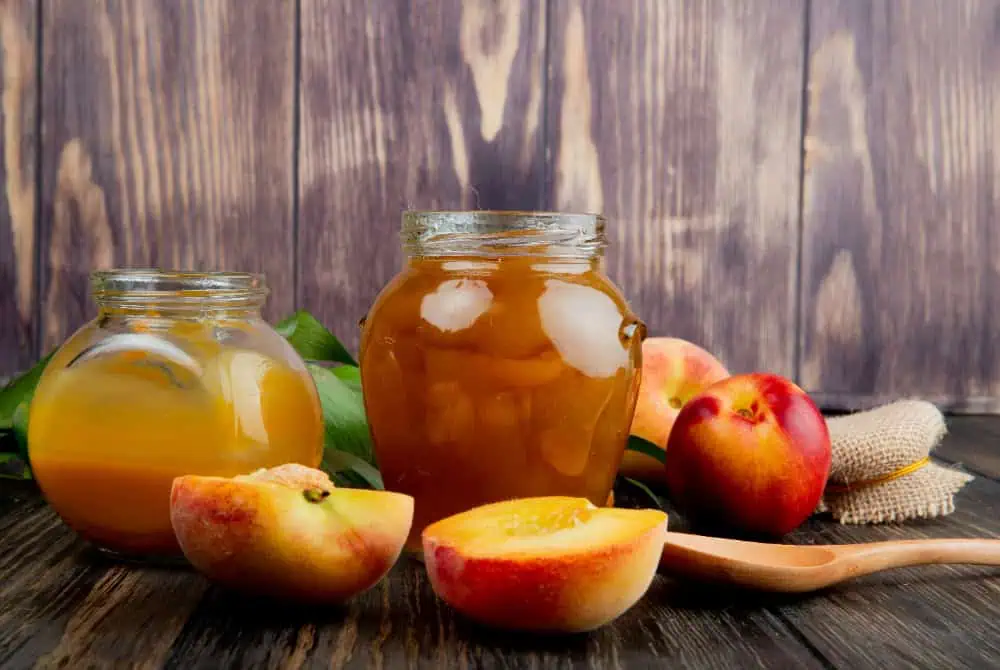Have you ever eagerly opened a jar of homemade peach jam, only to discover an unexpected bitter taste? If you’re wondering “why is my peach jam bitter,” you’re not alone. This comprehensive guide will help you understand the causes of bitter peach jam and provide practical solutions to ensure your next batch is perfectly sweet and delicious. From common mistakes to expert tips, we’ll cover everything you need to know about creating the perfect peach preserves.
Understanding Peach Jam Basics
The Science Behind Perfect Preserves
Before diving into bitter taste solutions, it’s essential to understand what makes great peach jam:
- Natural Fruit Pectin Content: Pectin is a natural thickening agent found in fruits. Peaches have varying levels of pectin, which affects the jam’s consistency.
- Sugar’s Role in Preservation: Sugar not only sweetens the jam but also acts as a preservative by inhibiting microbial growth.
- pH Balance Importance: The acidity of the fruit impacts the gelling process. A balanced pH is crucial for proper preservation and flavor.
- Chemical Reactions During Cooking: The Maillard reaction and caramelization can enhance flavors but may also lead to bitterness if not controlled.
Essential Ingredients for Success
Quality ingredients lead to superior results:
- Fresh, Ripe Peaches: The foundation of any good jam is high-quality fruit. Look for peaches that are fragrant, slightly soft, and free from blemishes.
- Granulated Sugar: Standard granulated sugar is commonly used, but you can also experiment with alternatives like brown sugar or honey for different flavor profiles.
- Commercial Pectin (if needed): Depending on the ripeness of your peaches, you may need to add pectin to achieve the desired consistency.
- Lemon Juice for Balance: The acidity of lemon juice helps balance the sweetness and enhances the flavor of the peaches.
- Clean Water: If needed, use clean water to adjust the consistency of your jam.
Common Causes of Bitter Peach Jam
The Role of Peach Pits and Kernels
One of the primary reasons peach jam becomes bitter is the accidental inclusion of peach pit fragments or kernels. These contain:
- Amygdalin: A compound that can create a bitter taste when broken down.
- Natural Chemicals: Certain compounds in the pits can affect the overall flavor profile of the jam.
- Trace Elements: Elements released during cooking can alter the taste, leading to bitterness.
Overripe or Underripe Fruit Issues
The ripeness of your peaches significantly impacts jam quality:
- Underripe Peaches: These contain more tannins, which can impart a bitter flavor. They also have less sugar, making the jam less sweet.
- Overripe Fruit: While they may seem ideal for jam, overripe peaches can develop off-flavors and a mushy texture, leading to bitterness.
- Optimal Ripeness: Choosing peaches that are perfectly ripe ensures the right balance of sweetness and acidity, resulting in a more flavorful jam.
Cooking Time and Temperature Problems
Bitter peach preserves often result from improper cooking methods:
- Overcooking: Cooking the jam for too long can caramelize the sugars, leading to a burnt or bitter taste.
- High Temperatures: Cooking at excessively high temperatures may scorch the mixture, imparting a bitter flavor.
- Extended Cooking Times: Prolonged cooking can concentrate bitter compounds, especially if the mixture is left unattended.
- Uneven Heating: Using cookware that doesn’t distribute heat evenly can create hot spots, leading to burning and bitterness.

How to Prevent Bitter Peach Jam
Proper Fruit Selection and Preparation
To avoid bitter taste in peach jam:
- Choose Perfectly Ripe Peaches: Look for peaches that yield slightly to pressure and have a sweet aroma.
- Remove All Pit Fragments Carefully: Ensure that no pit pieces are left in the fruit before cooking.
- Peel Peaches Properly: While some recipes call for leaving the skin on, peeling can help reduce bitterness.
- Clean Fruit Thoroughly: Wash peaches to remove any pesticides or contaminants that could affect flavor.
- Inspect for Bruising or Damage: Discard any damaged fruit, as it can introduce off-flavors.
Correct Sugar Ratios
Balance is crucial for perfect jam:
- Use Proper Sugar-to-Fruit Ratios: A common ratio is 1:1 (sugar to fruit), but this can vary based on the sweetness of the peaches.
- Consider Pectin Requirements: If using commercial pectin, follow the package instructions for sugar ratios.
- Adjust for Fruit Ripeness: If your peaches are particularly sweet or tart, adjust the sugar accordingly.
- Measure Ingredients Precisely: Accurate measurements ensure consistent results and prevent bitterness.
Temperature Control Tips
Maintain optimal cooking conditions:
- Use Medium Heat: Cooking at medium heat allows for even cooking without scorching.
- Stir Regularly: Frequent stirring prevents sticking and ensures even heat distribution.
- Monitor Temperature Consistently: Use a candy thermometer to keep track of the cooking temperature.
- Avoid Scorching: If you notice any signs of burning, reduce the heat immediately and stir well.
- Use Appropriate Cookware: Heavy-bottomed pots distribute heat evenly and reduce the risk of burning.
Advanced Techniques for Perfect Preserves
Professional Methods
Experienced canners use these approaches:
- Small Batch Processing: Making smaller batches allows for better control over cooking times and flavors.
- Precise Temperature Monitoring: Using a digital thermometer can help achieve the perfect cooking temperature.
- Quality Testing Procedures: Conducting taste tests during the cooking process can help identify any bitterness early on.
- Systematic Documentation: Keeping a detailed record of your recipes and modifications can help you replicate successful batches.
- Regular Equipment Calibration: Ensure that your cooking equipment is functioning correctly to avoid temperature inconsistencies.
Equipment Considerations
Proper tools make a difference:
- Heavy-Bottom Preserving Pans: These help prevent scorching and ensure even heat distribution.
- Digital Thermometers: Accurate temperature readings are crucial for achieving the right consistency.
- pH Testing Strips: These can help you monitor the acidity of your jam, ensuring it’s within the ideal range.
- Proper Canning Equipment: Invest in quality jars, lids, and sealing tools to ensure safe preservation.
- Storage Containers: Use airtight containers to keep your jam fresh and prevent spoilage.
Fixing Bitter Peach Jam
Immediate Solutions
If your peach jam tastes bitter, try these fixes:
- Add More Sugar Gradually: Start by adding small amounts of sugar and tasting until the bitterness is balanced.
- Include a Pinch of Salt: A small amount of salt can help counteract bitterness and enhance sweetness.
- Blend with Non-Bitter Jam: Mixing your bitter jam with a sweeter variety can help mask the bitterness.
- Add Citrus Juice: A splash of lemon or orange juice can brighten the flavor and reduce bitterness.
- Incorporate Vanilla Extract: Vanilla can add a pleasant sweetness that may help balance out the bitterness.
- Consider Honey Addition: Honey can provide a different flavor profile and sweetness that may help mask bitterness.
Long-term Prevention Strategies
Prevent future bitter batches by:
- Using Tested Recipes: Stick to tried-and-true recipes that have been successful for others.
- Taking Detailed Notes: Document your process, including any changes made, to learn from each batch.
- Investing in Proper Equipment: Quality tools can make a significant difference in the outcome of your jam.
- Following Safe Canning Practices: Adhering to food safety guidelines can prevent contamination and off-flavors.
- Building Experience Gradually: The more you practice, the better you’ll become at identifying and correcting issues.
Best Practices for Perfect Peach Jam
Equipment Essentials
Gather these tools:
- Heavy-Bottomed Pot: Essential for even cooking and preventing scorching.
- Candy Thermometer: Helps monitor the temperature for perfect consistency.
- Sharp Paring Knife: Useful for peeling and cutting peaches.
- Clean Canning Jars: Ensure all jars are sterilized before use.
- Proper Sealing Lids: Use new lids for each batch to ensure a proper seal.
- Canning Tools Set: A set that includes a jar lifter, funnel, and magnetic lid lifter can make the process easier.
Step-by-Step Process
- Prepare Peaches Properly: Wash, peel, and pit the peaches, ensuring no fragments remain.
- Remove All Pit Fragments: Double-check for any small pieces that could affect flavor.
- Add Correct Ingredients: Measure and mix your ingredients according to your recipe.
- Cook at Proper Temperature: Use medium heat and stir frequently to prevent burning.
- Test for Doneness: Use the plate test or thermometer to check if the jam has reached the right consistency.
- Process Safely: Follow proper canning procedures to ensure your jam is safe for storage.
- Cool Completely: Allow jars to cool at room temperature before storing.
- Check Seals: Ensure that all jars are sealed properly before storing.
- Label and Store: Label jars with the date and type of jam, and store them in a cool, dark place.
Seasonal Considerations
Best Time for Peach Jam Making
Timing affects quality:
- Peak Season Selection: The best time to make peach jam is during the peak peach season, typically late summer.
- Fruit Ripeness: Ensure that the peaches are at their peak ripeness for the best flavor.
- Weather Conditions: Hot, dry weather can lead to sweeter peaches, while cooler, wetter conditions may affect sweetness.
- Market Availability: Local farmers’ markets often have the freshest peaches during peak season.
- Price Considerations: Buying in bulk during peak season can save money and ensure quality.
Storage and Preservation
Proper storage ensures longevity:
- Cool, Dark Locations: Store your jam in a cool, dark place to prevent spoilage.
- Proper Sealing Methods: Ensure that all jars are sealed correctly to prevent air from entering.
- Regular Inspection: Check your jars periodically for any signs of spoilage or compromised seals.
- Rotation System: Use a first-in, first-out (FIFO) system to ensure older jars are used first.
- Temperature Monitoring: Keep your storage area at a consistent temperature to maintain quality.
- Humidity Control: Avoid storing in humid areas, as moisture can lead to spoilage.

FAQs About Bitter Peach Jam
Why does my peach jam taste like alcohol?
Fermentation can occur if:
- Improper Storage Conditions Exist: If the jam is stored in a warm environment, it may ferment.
- Sugar Ratios Are Incorrect: Too little sugar can lead to fermentation.
- Contamination Occurred During Canning: Bacteria can introduce fermentation if jars are not properly sterilized.
- Temperature Fluctuations Happened: If the jam was not processed correctly, it may ferment.
- Seals Were Compromised: A broken seal can allow air in, leading to fermentation.
- Processing Was Inadequate: Not cooking the jam long enough can result in fermentation.
Can I fix bitter peach jam after canning?
While challenging, you can:
- Reprocess with Additional Sugar: Heat the jam again and add sugar to balance the flavor.
- Blend with Non-Bitter Preserves: Mixing with a sweeter jam can help mask the bitterness.
- Use It in Recipes Where Bitterness Is Less Noticeable: Incorporate it into baked goods or sauces.
- Add Complementary Flavors: Consider adding spices or citrus to enhance the flavor.
- Adjust Seasoning Carefully: Taste and adjust as needed to find the right balance.
- Consider Alternative Uses: Use it as a glaze for meats or in salad dressings.
Should peach jam be made with skin on?
Consider these factors:
- Skins Contain Beneficial Pectin: Leaving the skin on can help with gelling.
- Some Prefer Smooth Texture Without Skins: If you prefer a smoother jam, peeling is recommended.
- Properly Peeled Fruit Reduces Bitter Compounds: Peeling can help eliminate any bitterness from the skin.
- Texture Variations: Skins can add texture, which some may enjoy.
- Processing Time Differences: Cooking times may vary based on whether the skins are included.
- Personal Preference Impact: Ultimately, it comes down to personal taste.
How long should peach jam cook?
Optimal cooking times:
- 20-30 Minutes Average: This is a general guideline, but it can vary based on the recipe.
- Until Reaching 220°F (104°C): This is the temperature at which the jam will set properly.
- When It Passes the Plate Test: Place a small amount on a cold plate; if it holds its shape, it’s done.
- Consistency Checks: Look for a thick, syrupy texture.
- Visual Cues: The jam should change color and become glossy.
- Texture Assessment: It should be spreadable but not runny.
Expert Tips for Success
Quality Control Measures
Maintain consistency by:
- Testing Each Batch: Regularly taste your jam during cooking to catch any bitterness early.
- Recording Modifications: Keep track of any changes made to recipes for future reference.
- Sampling Before Canning: Taste the jam before sealing to ensure it meets your expectations.
- Labeling Properly: Clearly label jars with the date and type of jam for easy identification.
- Maintaining Cleanliness: Ensure all equipment is clean to prevent contamination.
- Following Food Safety Guidelines: Adhere to safe canning practices to avoid spoilage.
Troubleshooting Guide
Address common issues:
- Color Changes: If your jam darkens too much, it may be overcooked. Adjust cooking times in the future.
- Texture Problems: If the jam is too runny, consider adding more pectin or cooking longer.
- Setting Difficulties: If the jam doesn’t set, reprocess with additional pectin and sugar.
- Flavor Imbalances: Adjust sweetness or acidity as needed to balance flavors.
- Storage Concerns: Ensure jars are sealed properly and stored in a cool, dark place.
- Safety Considerations: Always check for signs of spoilage before consuming.
Advanced Preservation Techniques
Modern Methods
Contemporary approaches include:
- Low-Sugar Options: Use low-sugar pectin to create healthier preserves.
- Natural Preservatives: Consider using natural preservatives like lemon juice or citric acid.
- Alternative Sweeteners: Experiment with honey, agave, or maple syrup for different flavor profiles.
- Pressure Canning: This method can be used for larger batches and ensures safety.
- Steam Processing: A gentler method that can help preserve flavor and color.
- Vacuum Sealing: This technique can extend the shelf life of your jam.
Traditional Wisdom
Time-tested techniques:
- Sun Ripening: Allowing peaches to ripen in the sun can enhance sweetness.
- Natural Pectin Use: Using fruits high in pectin, like apples, can help thicken your jam.
- Slow Cooking Methods: Cooking jam slowly can enhance flavors and reduce bitterness.
- Seasonal Timing: Making jam during peak peach season ensures the best flavor.
- Heritage Recipes: Explore family recipes that have stood the test of time.
- Canning Traditions: Embrace traditional canning methods for authentic flavors.
Conclusion
Understanding why peach jam becomes bitter is crucial for creating perfect preserves. By following these guidelines and implementing proper techniques, you can avoid bitter flavors and create delicious, sweet peach jam every time. Remember that practice makes perfect, and don’t be discouraged if your first attempts aren’t ideal. With these tips and solutions, your next batch of peach jam will be a sweet success!
Whether you’re a novice jam maker or an experienced canner, preventing and fixing bitter peach jam requires attention to detail and proper technique. By following these comprehensive guidelines and maintaining proper procedures, you’ll be well-equipped to create delicious, sweet peach preserves that your family and friends will love.
Final Thoughts
Making peach jam can be a rewarding experience, allowing you to capture the essence of summer in a jar. By understanding the factors that contribute to bitterness and implementing the strategies outlined in this guide, you can ensure that your peach jam is not only delicious but also a cherished addition to your pantry. Happy canning!

